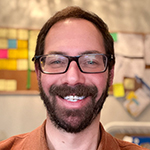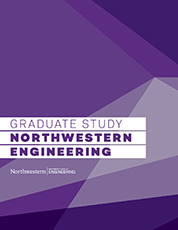Helping the Aging Population and their Caregivers
EDI’s Design Research course helped new students learn the foundation for human-centered design and develop ideas to promote care and independence.
What does an older person actually need? What about a family member caring for that older person?
Those questions provided the framework for students this fall in the Design Research course in Northwestern's Master of Science in Engineering Design Innovation (EDI) program.
The course is co-taught by adjunct lecturers Amy Schwartz and Michael Chapman. Together, the duo has more than 50 years of experience designing products and services based not on what the designer thinks the target audience needs, but rather on actual needs of users – both expressed and unexpressed.
 “A lot of students in the EDI program come from engineering backgrounds, and they tend to think functionally,” said Schwartz, who spent 20 years as director at IDEO before launching her own human-centered design firm in 2016. “Design Research is really the bedrock of human-centered design, where you build empathy around the problem and understanding of the people involved before you start to develop solutions that address needs at a variety of levels. Great design incorporates an understanding of emotional, social, and cultural needs along with the functional.”
“A lot of students in the EDI program come from engineering backgrounds, and they tend to think functionally,” said Schwartz, who spent 20 years as director at IDEO before launching her own human-centered design firm in 2016. “Design Research is really the bedrock of human-centered design, where you build empathy around the problem and understanding of the people involved before you start to develop solutions that address needs at a variety of levels. Great design incorporates an understanding of emotional, social, and cultural needs along with the functional.”
What that meant for the students in Schwartz’s and Chapman’s class this fall was a challenge to think beyond the apparent.
Students were split into teams and assigned one of four industries – health care, city services, technology, or home modification. Each team faced the same challenge: Find opportunities to support familial caregivers so they can continue helping their aging loved ones live to the fullest extent of their independence.
Discovering those true opportunities cannot be done in isolation and requires students to talk with and immerse themselves in the lives of the people facing the issue, the instructors said.
“We had a number of different caregivers who kept diaries, photographic diaries, that showed very clearly, ‘OK, here’s a typical day caring for my mom,'’' said Schwartz, a cognitive psychologist who served as the global design research lead for the IDEO health practice. “To be great designers, you must have empathy enter the equation.”
That empathy led students to a number of innovative solutions that stretched beyond the obvious.
For example, instead of creating an app for caregivers to bring them into a community with other caregivers in general, students found caregivers were more likely to join a community if it was made up of those with specific circumstances similar to their own – for example, daughters who are caregivers to mothers with Alzheimer’s Disease.

“Often teams want to jump straight to solutions,” said Chapman, a cultural anthropologist who works with Ascension Health as the senior director of experience research. “We work with them to embrace the problem space and work to understand it more deeply before generating ideas.”
Schwartz said her and Chapman having so many years of practical experience designing products and services that meet needs and are viable commercially is an advantage to EDI students.
“This is about looking for insights that have design energy, things that actually spark design ideas that are grounded in real needs people have,” she said. “Developing that ‘Spidey’ sense around design energy is one of the most important skills for a design researcher. Michael and I do that for a living.”
Chapman agreed.
"We are able to give the unvarnished telling of how products and services came to be," he said. "It is easy to tell a story and make all the turbulence and dead ends and mistakes sound polished. We try to help them understand the lived experience of actually going through that."

